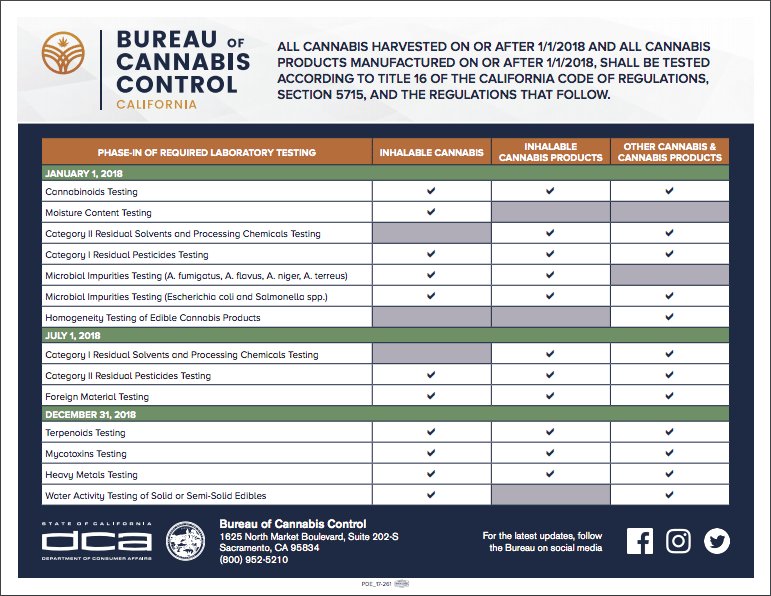California’s Cannabis Regulatory “Transition Period” to end on June 30

June 25, 2018 – The Emergency Cannabis Regulations adopted by the Bureau of Cannabis Control, the Department of Food and Agriculture, and the Department of Public Health included a “Transition Period” which carved out exceptions to certain regulations in order to make the transition to the regulated market less burdensome for operators. However, on June 30, 2018, this transition period will end. Beginning July 1, 2018, cannabis goods that do not meet the emergency regulations’ standards in terms of laboratory testing, packaging and labeling, ingredients and appearance, and THC limits may not be sold to consumers. Certain non-compliant products must be destroyed, which is discussed further below.
Laboratory Testing Requirements
Beginning July 1, 2018, a licensee may only sell cannabis goods that have been tested and passed all testing requirements in effect at the time of testing. Note that there are new testing requirements that will go into effect on July 1, 2018, discussed further below.
Untested cannabis goods cannot be sold by a retailer and must be destroyed. A retailer may not send cannabis goods to a distributor for testing. Untested cannabis goods that were manufactured or harvested before January 1, 2018, which are in possession of a distributor and that are owned by the distributor, must be destroyed.
Untested cannabis goods that were manufactured or harvested before January 1, 2018, and that are in the possession of a distributor but are owned by a manufacturer or cultivator, may be returned to the licensee who owns the cannabis goods. If a cultivator or manufacturer chooses to sell the returned cannabis goods, the cannabis goods must be sent to a distributor for testing and must meet all of the testing requirements in effect at the time of testing before transported to a retailer for sale.
As noted above, there are new laboratory testing requirements for cannabis that go into effect on July 1, 2018. Specifically, the new tests that will be required of any cannabis goods testing on or after that date will now include Category I Residual Solvents and Processing Chemicals Testing, Category II Residual Pesticides Testing, and Foreign Material Testing in addition to the tests that were required as of January 1, 2018. This is indicated in the following chart, which is reprinted below: BCC Required Testing Chart

A final phase-in of testing requirements will occur on December 31, 2018. As of June 25, 2018 there are only 30 licensed testing labs throughout the State of California. Many people are concerned that the limited number of licensed testing facilities combined with the new, more stringent testing requirements, will result in a bottleneck and a lack of compliant cannabis goods on the legal market after July 1.
Packaging and Labeling Requirements
Beginning on July 1, 2018 all packaging and labeling must be done prior to the cannabis goods being transported to a retailer. Retailers won’t be able to accept goods that aren’t properly packaged and labeled. Retailers cannot package or label cannabis goods, even if they were in the retailer’s inventory prior to July 1. However, for medicinal sales, retailers can place a sticker on cannabis goods stating, “FOR MEDICAL USE ONLY” upon sale to a qualified medicinal consumer, unless the statement is already printed on the package.
Retailers cannot send unpackaged goods to another licensee for packaging and labeling. Any cannabis goods in possession of a retailer that do not meet packaging and labeling requirements must be destroyed.
Exit packaging is not required to be child-resistant and can no longer be used to satisfy the child-resistant packaging requirements. All cannabis goods must be in child-resistant packaging prior to delivery to a retailer. (Note: Edible cannabis products must be in packaging that maintains the child-resistant nature throughout the life of the package. Other types of cannabis goods must be in packaging that are only initially child-resistant.)
THC Limits for Edible and Non-Edible Products
Beginning on July 1, 2018, edible cannabis goods cannot contain more than 10mg of THC per serving, and cannot contain more than 100mg of THC per package. This applies to both medicinal and adult-use edible products. Additionally, non-edible cannabis goods cannot contain more than 1,000mg of THC per package if intended for the adult-use market, and cannot contain more than 2,000mg of THC per package if intended for the medicinal market.
Ingredients and Appearance of Cannabis Products
Beginning July 1, 2018, a retailer may only sell cannabis products that meet the requirements set by the California Department of Public Health for ingredients or appearance.
This information is provided as a public service. It is not intended as legal advice. For specific questions regarding compliance with California’s cannabis laws and regulations, please contact us at (707) 829-0215 or info@omarfigueroa.com to schedule a confidential legal consultation.
